Since I began Vlytics in 2007 I have heard a lot thrown out about “Micro-Targeting” for political campaigns. More recently I have heard people describing Micro-Targeting as the magic that got Obama elected to those describing it as the over-priced snake oil that sunk Hillary Clinton’s campaign.
Some other interesting musings I have heard:
1. “Micro-Targeting, that’s where you target short voters?”
2. “Micro-Targeting only works on a small/large scale”
3. “Micro-Targeting is too expensive”
4. “Micro-Targeting is the edge every campaign needs”
5. “Micro-Targeting is all about finding groups of voters – stuff I already know”
So with that in mind I will be doing a 5 part blog series introducing you all to Micro-Targeting using the above statements as guidance.
Lets start out with defining Micro-Targeting.
Micro-Targeting is the method of using various data attributes to profile common correlations of those attributes and patterns of behavior.*
Basically all that means is that consultants look at all recordable data on an individual level (i.e. Micro level) then look at a behavioral symptom by that individual and try and find correlations.
For instance, if a person buys Skittles (behavioral symptom) and generally speaking 90% of the people who buy skittles (are under the age of 23 (recordable data attribute) and live in suburban areas (recordable attributes). So if your trying to sell skittles and you want to try and contact those who are most likely to buy you would seek out the under 23 crowd who live in the suburbs.
The above is a way oversimplified example but the underlying principles remain the same, get a enough data on a large amount of people, define an action, then find singular or combinations of data attributes on those people and see if they overwhelming correlate to the defined action.
Usually focus groups, surveys, and lots of statistical modeling is involved as data must be recorded, normalized, and then extrapolated across millions of people. If the best way to figure out what someone likes or dislikes is to ask them then Micro-Targeting is the next best thing as they ask a smaller controlled group and then use mathematical models to extrapolate those findings across much larger datasets.
The interesting aspect of micro targeting as it applies to politics is much of it may come across as common-sense. If you’re a politician looking to sway voters on your refundable tax credit for leased condos then it’s pretty obvious you’re going to try and target those who rent a condo and are registered voters.
The more elaborate micro-targeting examples go back to targeting “Soccer Moms” or “Nascar Dads.” It’s not as simple as finding a guy with a kid who watches Nascar, these names are titles that describe a whole subset of data attributes (dozens if not hundreds) and if a person clears the threshold with enough positive attributes they fit into that category (i.e. Nascar Dad) of people who may be persuadable to a candidate or political position. These large datasets and pools are often combined with focus groups. The focus groups help determine political views and then they’re attributes
This is a perfect time to bring up the difference between correlation and causation. Correlation is often not causation. In the Skittles example the fact that the likely buyers lived in the suburbs and were under the age of 23 are not causative rather correlative. In the condo example the fact that people who own condos and are registered voters is a causative attribute that indicates they’re likelihood to support.
So that’s your introduction to Micro-Targeting. Next up we’ll look at whether Micro-Targeting works on large scales, small scales, medium scales, or no scales.
*I should point out that this is my personal definition of Micro-Targeting and may differ slightly from others in the industry. Check out the Wikipedia page on Micro-Targeting to learn even more.
**I will periodically amend this post as needed.

